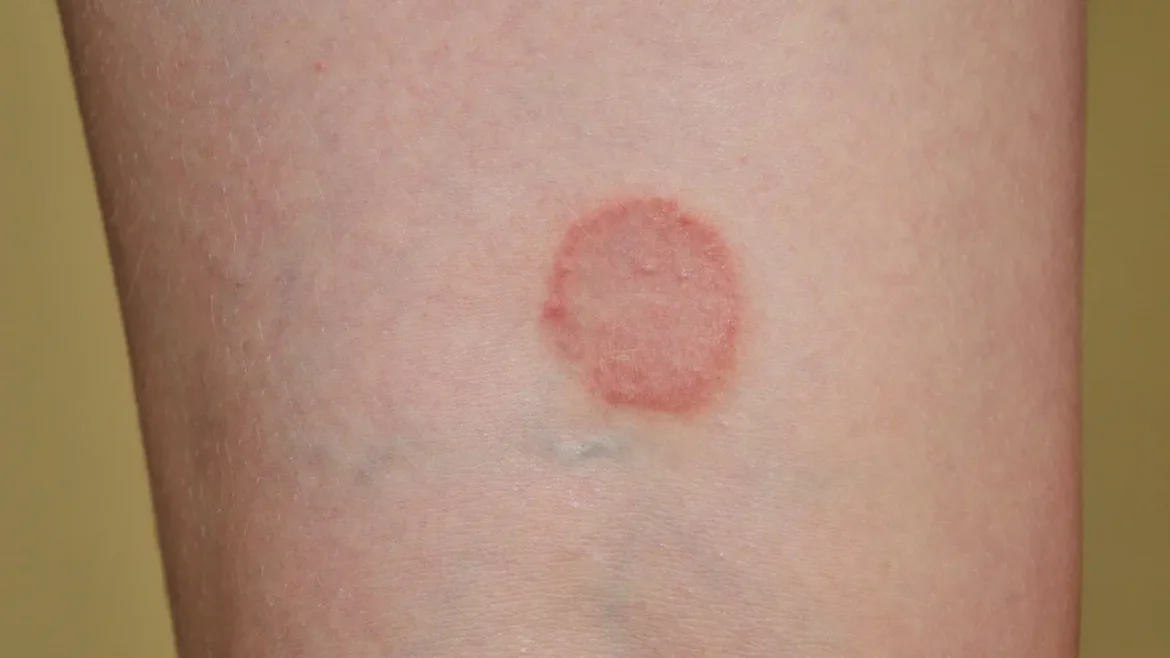Description
Contrary to its name, ringworm is actually a fungal infection rather than a worm. It is extremely contagious and may be spread by close interaction with an infected person or by touching materials that are contaminated. Ringworm appears as itchy, scaly, and red areas on the skin with circular or ring-like patterns. It can impact several bodily parts, including the feet, nails, groin, body, and scalp. Dermatophyte fungi, primarily Microsporum, Trichophyton, and Epidermophyton species, are responsible for the infection.
You May Also Like:
5 GREAT WAYS TO REDUCE STRESS AND ELEVATE MOOD WITHOUT ALCOHOL
OXIDATIVE STRESS SUPPLEMENTS, AND HOW THEY WORK AT THE CELLULAR LEVEL: MITOQ HAS PROMISING ANSWERS
Ringworm: Description, Causes, And Treatment Protocol is an original (HealthXWire) article.
Possible Causes
Dermatophytes also referred to as dermatophytosis are what causes ringworm. Ringworm is most frequently caused by the dermatophyte species Trichophyton, Epidermophyton, and Microsporum. These fungi may affect the skin, hair, and nails and may grow in specific environments. The following are potential ringworm triggers: –
Direct interaction with an infected individual or animal: Ringworm can be extremely contagious and might be passed from person to person or animal to animal through close contact. The fungi that cause ringworm can be spread through contacting the hair, skin, or personal items of an infected human or animal.
Indirect interaction with contaminated objects: On surfaces and items including clothing, towels, brushes, combs, and shared sporting goods, dermatophytes can persist. Contact with these infected items can result in the spread of fungi and consequent ringworm infection.
Warm and humid surroundings: Warm, humid environments are typically favorable for dermatophytes. Living in humid surroundings, including tropical or subtropical areas, or sweating excessively might foster the growth of fungi and raise the possibility of ringworm.
Poor personal hygiene: Poor personal hygiene habits, such as neglecting to wash hands frequently or failing to keep the environment clean, can raise the chance of developing ringworm. In unhygienic surroundings, fungi can grow and spread.
Weakened immune system: People who have compromised immune systems, like those having HIV/AIDS, cancer patients, or those using immunosuppressive drugs, are more vulnerable to fungi like ringworm. A weak immune system makes it harder for the body to fight against infection successfully.
Sharing personal items: Transmission of ringworm can occur when personal objects like clothing, towels, combs, and hairbrushes are shared with an infected person. These products may harbor fungal spores that can spread to those who come into touch with them.
Unhealthy foot hygiene with wearing tight shoes: If left untreated, athlete’s foot, a fungal infection of the feet, may develop into ringworm. Poor foot hygiene may foster the formation of fungus. These behaviors include wearing wet socks and shoes, failing to adequately dry the feet, and other behaviors.
Close contact activities: Ringworm risk can be raised by engaging in close contact activities including contact sports like football, wrestling, and martial arts, along with sharing common areas like locker rooms or dorms. These activities offer chances for the fungi to be transmitted by immediate contact with the skin.
Exacerbating and Mitigating Factors
Exacerbating Factors: –
Occlusive or constricting clothing: Wearing clothing that is too tight or obstructive can foster a warm, damp environment that encourages fungal development and perpetuation of ringworm. Additionally, friction might aggravate symptoms and irritate the skin.
Prolonged dampness: The dermatophyte fungi that cause ringworm thrive in moist settings. The development and transmission of the disease can be accelerated by persistent skin wetness, such as from excessive perspiration or improper drying of the affected region.
Scratching the affected region: Scratching ringworm lesions raises the danger of subsequent infections due to skin damage and increases susceptibility to bacterial infection.
Close encounters with diseased people or animals: The ringworm-causing fungus can spread by interacting directly with an infected individual or animal. Activities that involve close contact, like playing sports, sharing personal goods, or residing in crowded areas, can increase the probability of catching the infection.
Weakened immune system: People who have weakened immune systems have a lower body’s capacity to fight off the illness.
Mitigating Factors: –
Loose-fitting clothing: A fungus-unfriendly atmosphere is created by wearing loose-fitting clothes, which promotes air circulation and decreases moisture build-up. Additionally, it lessens friction and irritability in the affected region.
Good personal hygiene: Ringworm can be stopped from spreading and returning by practicing good personal hygiene. The possibility of transmission can be decreased by frequently cleaning and drying the region infected and refraining from sharing personal things.
Keeping the afflicted region dry: In order to manage ringworm, it is essential to keep the affected region dry and clean. One must completely dry the affected region after bathing or cleaning it because any moisture can encourage the growth of fungi.
Staying away from infectious people or animals: Ringworms must be kept from spreading by avoiding close contact with sick people or animals. This entails avoiding activities that entail immediate contact with the skin and not sharing personal objects like towels, shirts, or combs.
Environmental precautions: Precautions might help lessen the chance of acquiring the illness in ringworm-prone settings like gym locker rooms, public showers, and communal areas. In such settings, it can be useful to wear protective footwear and practice good hygiene.
Treating underlying medical issues: It is critical to monitor effectively and treat any underlying medical conditions that affect an individual’s immune system.

Standard Treatment Protocol
The location and intensity of the illness determine the ringworm treatment protocol. Usually, antifungal drugs are used, either orally or topically. The general procedure to cure ringworm is outlined in the steps below: –
Good hygiene practices: To stop the recurrence and transmission of ringworm, it is essential to practice good personal cleanliness. This involves maintaining the infected region tidy and dry, abstaining from sharing private objects like clothing, combs, and towels, together with washing the hands completely after touching the region that is infected.
Topical antifungal medications: Topical antifungal lotions, creams, or powders are frequently recommended for mild to moderate ringworm cases. The topical antifungal medications terbinafine, clotrimazole, miconazole, and ketoconazole are frequently used. As instructed by the healthcare provider, these drugs should be immediately applied to the affected region. Even if symptoms subside sooner, it is crucial to keep continuing to use medication for the full prescribed time.
Oral antifungal medications: Oral antifungal drugs may be recommended if the infection is serious, pervasive, or unresponsive to topical therapy. Itraconazole, fluconazole, and terbinafine are examples of regularly used drugs. Typically, oral drugs are regularly taken for a few weeks; the precise amount of time depends on the doctor’s advice.
Consultation with a medical expert: For a precise diagnosis and suggested treatments, it is crucial to seek medical guidance. A healthcare provider can evaluate the infection’s severity, choose the best course of action, and give detailed directions for prescription administration.

Treatment Options
There are several adjunct therapy options that can be taken into account as a complement to the regular treatment regimen to increase the effectiveness of traditional therapies. The following are a few other ringworm treatment methods: –
Nutritional supplements: Dietary supplements with minerals and vitamins that promote immune system functioning and skin health might be regarded as adjuvant therapy. These consist of selenium, zinc, and vitamins A, D, C, and E. Before beginning any supplements, it is essential to speak with a healthcare provider to identify the right dosage and any possible drug interactions.
Natural remedies: Some herbal remedies might be antifungal and could be used in addition to conventional therapies. For instance, after being diluted, tea tree oil may be used topically and is thought to have antifungal qualities. Although their effectiveness has not been definitively shown, additional natural therapies including garlic, aloe vera, apple cider vinegar, coconut oil, and turmeric can also be taken into consideration.
Herbal remedies: The antifungal effects of several herbs have been utilized historically. Examples include grapefruit seed extract, pau d’arco, and oregano oil. Herbal medications such as these come in a variety of packaging, including oils, extracts, and capsules. Owing to possible interactions and variances in individual reactions, it is crucial to remember that using herbal treatments must be done based on the supervision of a healthcare practitioner.
Lifestyle modifications: A few lifestyle changes can aid in recovery and stop the recurrence of ringworm. These involve keeping dry and clean surroundings, preventing clothing that is restrictive or occlusive that might retain moisture, and practicing proper personal hygiene, which includes routinely cleaning and drying bedding, towels, and clothing.
However, it is crucial to note that, despite the possibility of exploring adjunct therapies, these treatments should not take the place of the conventional course of action advised by a medical expert.

Conclusion
Ringworm is a very common fungal skin infection that may be spread by contaminated items or close contact with the infected person. Timely diagnosis and appropriate management are essential in preventing the spread of ringworm. Antifungal medications, topical creams, or oral formulations are used to treat ringworm. Personal hygiene, such as keeping the affected area clean and dry can mitigate the symptoms and help prevent further spread. Since it is a fungus infection, warm and humid environments should be avoided and items should not be shared with the infected person to contain the infection. By promptly seeking medical attention, following prescribed treatments, and practicing preventive measures, individuals can effectively manage this illness and it can also be easily treated.

Additional resources for further reference
https://www.aad.org/public/diseases/a-z/ringworm-symptoms
https://www.cdc.gov/fungal/diseases/ringworm/index.html
https://my.clevelandclinic.org/health/diseases/4560-ringworm
https://www.healthline.com/health/ringworm
Important Note: The information contained in this article is for general informational purposes only, and should not be construed as health or medical advice, nor is it intended to diagnose, prevent, treat, or cure any disease or health condition. Before embarking on any diet, fitness regimen, or program of nutritional supplementation, it is advisable to consult your healthcare professional in order to determine its safety and probable efficacy in terms of your individual state of health.
Regarding Nutritional Supplements Or Other Non-Prescription Health Products: If any nutritional supplements or other non-prescription health products are mentioned in the foregoing article, any claims or statements made about them have not been evaluated by the U.S. Food and Drug Administration, and such nutritional supplements or other health products are not intended to diagnose, treat, cure, or prevent any disease.
Table of Contents


